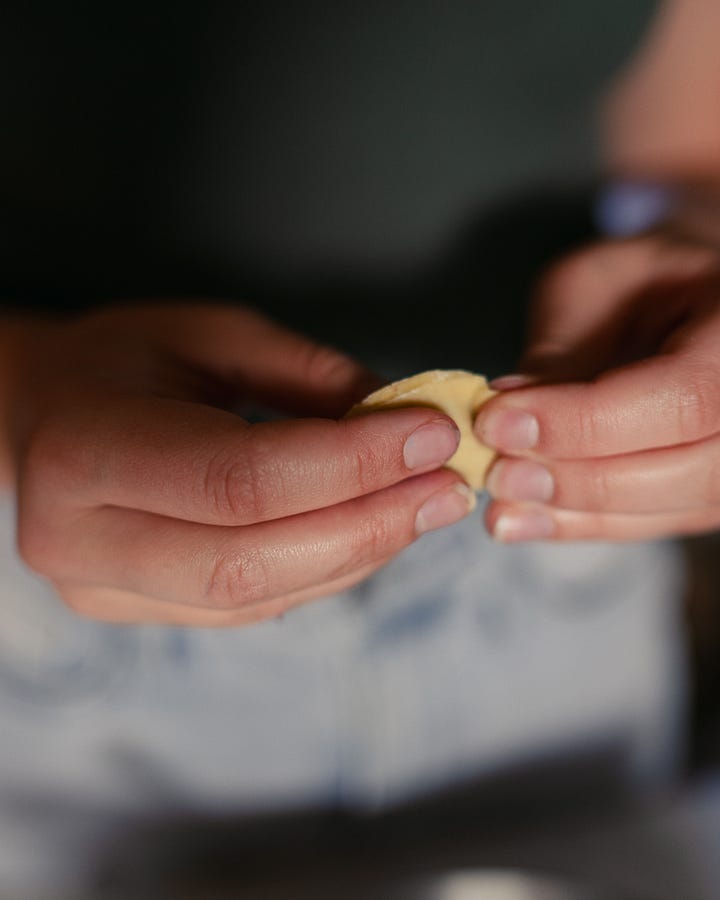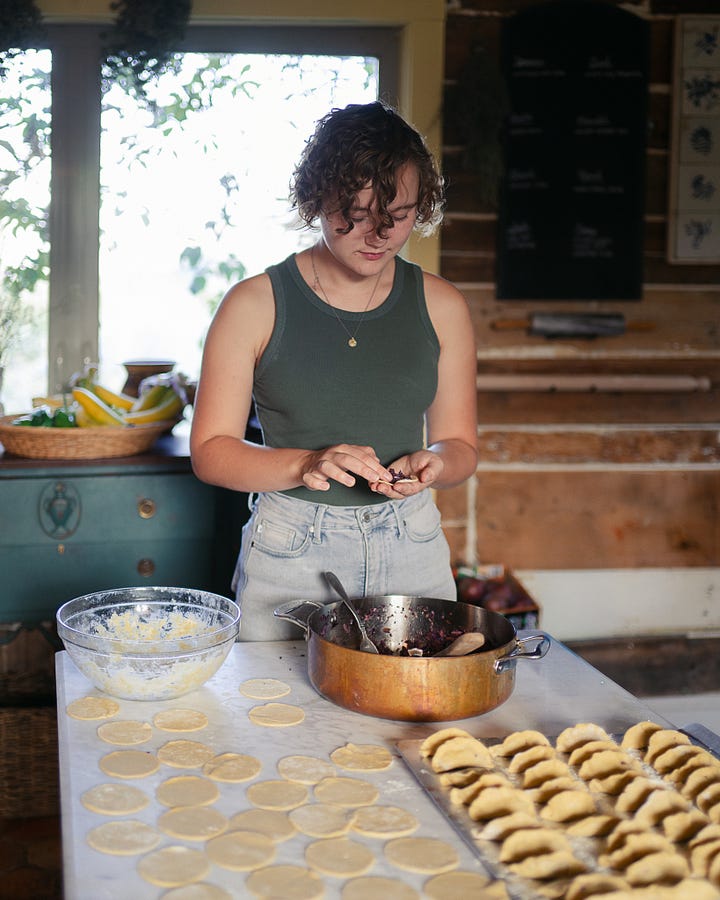When all else fails, make pasta
🍝 My best, most comforting pasta bolognese recipe
Hi friend,
When all is moving too fast, too wildly, too out of control, I turn inwards towards something I can make with my hands in the kitchen.
The culinary manifestation of this effort is always simple: perhaps a spiced loaf of banana bread or bowl of chicken and dumplings — a visual (and delicious) focus for my efforts and mind.
But more often than not, I make pasta. I will confess that I’ve learned the hard way: one mustn’t make pasta with a bad attitude.
Like bread, the pasta somehow knows when the maker is angry or rushed. This isn’t a time to knead away one’s frustrations, putting such energy into the dough. Instead, the slow, gentle, soft kneading is meant to transform the maker.
Rather than mixing worries into the dough, I allow the dough to work the worries out of me.
This is why the actions of our hands are always more than actions. They’re a statement of something: from how we’re feeling to how we’re celebrating.
When I make bolognese ( recipe below or right here), my family usually knows I’m working through something. We’ve even called it “grief bolognese” because bolognese offers me the very greatest comfort of any food. Sometimes, I need it.
Don’t we all?


When I need to settle myself, one of the greatest tasks I can do is make something.
Georgia and I stood together in the kitchen for hours last week, stuffing homemade potstickers with a slow-simmered cabbage and carrot filling.
We made bolognese (obv).
We also made eight loaves of slow-rise, sourdough bread. Mix. Rest. Fold. Repeat.
You don’t have to be grieving or upset to make food slowly and intentionally, but if this email finds you in such a moment, know that it helps.
Open your windows for some of that autumnal air, light a new candle, and put your hands to work. Our hearts mend through the efforts of our hands. And at the end? We have some excellent, delicious food to fill the bellies of our loved ones.
As we enjoyed big plates of bolognese with homemade egg pasta this past week, my children proclaimed that each noodle felt important to them — after all, they’d watched me mix and knead, rest and roll, cut and simmer, boil and serve.
If we can find what’s good, true, and beautiful in a handmade noodle, I think it will be okay after all.
Basic Egg Pasta Dough
Per person
90 grams all-purpose flour or “00” flour
55 grams egg (the standard weight of one egg)
In a bowl or on a work surface, make a mound with the flour. Use your hands to create a well in the center of the four. Add the egg into the well.
Use your hands, or a fork, to combine the egg and flour until a dough is formed.
On a lightly floured work surface, knead the dough for 5-10 minutes until soft. A very small amount of flour can be added if the dough is sticky.
Cover the dough with a damp tea towel and let it rest.
Divide the dough into as many servings as you made. Roll the pasta dough with a pasta roller until it is 1/8” thick. Cut it into noodles as desired and boil in salted water for 1-2 minutes or until tender.
The Best Bolognese
A basic bolognese is built on a few basic principles: time and good ingredients. Left for a day in the refrigerator, it becomes even more delicious, as the flavors melt together. Though it takes a few hours to prepare, the effort is minimal.
4 tablespoons butter
2 carrots, minced
1 small onion or 2 shallots, minced
1 pound ground beef
1 pound ground pork
1 bottle white wine
4 cups whole milk*
2 (18-ounce) jars crushed tomatoes
½ cup heavy cream*
*Omit for your dairy-intolerant loved ones and add a bit of olive oil instead!
Melt the butter in a large heavy-bottomed skillet or Dutch oven over medium heat.
Add in the carrots and onion and saute for five minutes, until just soft.
Add the beef and pork to the skillet and allow the meat to just gently cook, not brown, stirring occasionally and breaking up any large pieces with your mixing spoon.
Pour in the wine. Allow the mixture to simmer for twenty minutes while some of the wine evaporates.
Pour in the milk. Once again, allow the mixture to simmer for another twenty minutes.
Add the tomatoes, stir, and allow the mixture to simmer for another hour until it is thick.
Turn off the heat, add heavy cream, and stir.
Season to taste with salt and pepper, and enjoy.
This is a wonderful pasta rolling-pin I keep on hand for such occasions — and this is a pasta chittara that can be used to cut the noodles if you’re so inclined. If not, fold up the rolled-out dough gently, use a knife to cut it into noodles, and embrace the beautiful, knobby imperfections of all things homemade.
That’s the really good stuff anyway.
Love,






I am feeling a little bit of synchronicity right now, Shaye. I retired about a year and a half ago. I've been banging around the house sort of waiting for the future to reveal itself. I've just noticed that I'm doing a lot of cooking now. I also notice that I really like doing it. I like thinking about what I'm going to cook. I like getting the stuff together. I like the act and I like eating my work. I also like other people eating my work even more. Today I'm making an apple prune cake and lamb shoulder chops with potatoes in the Greek style (very well done lamb is my favorite). I've been taking on more challenges, like baking Pan de Cristal for instance, and I've really been leaning into the idea of making scratch pasta. You sent me the sign today. I'm making pasta tomorrow. Cooking is a refuge for me too. I guess all art is. Anyway, have a good one and Thanks for the inspiration..
Your bolognese is one of my family’s all time favorite things. It’s also a go-to for meal trains for all manner of needs. It freezes well and gets so much appreciation. It’s comforting and hearty, a hug in a pot! Thank you for this blessing of a recipe. I haven’t made my own pasta yet…maybe this is the year. I love the image of you and your daughter making this together, I have daughters too. Some wonderful conversations happen when we set our hands to a task in the kitchen like this. Happy fall!